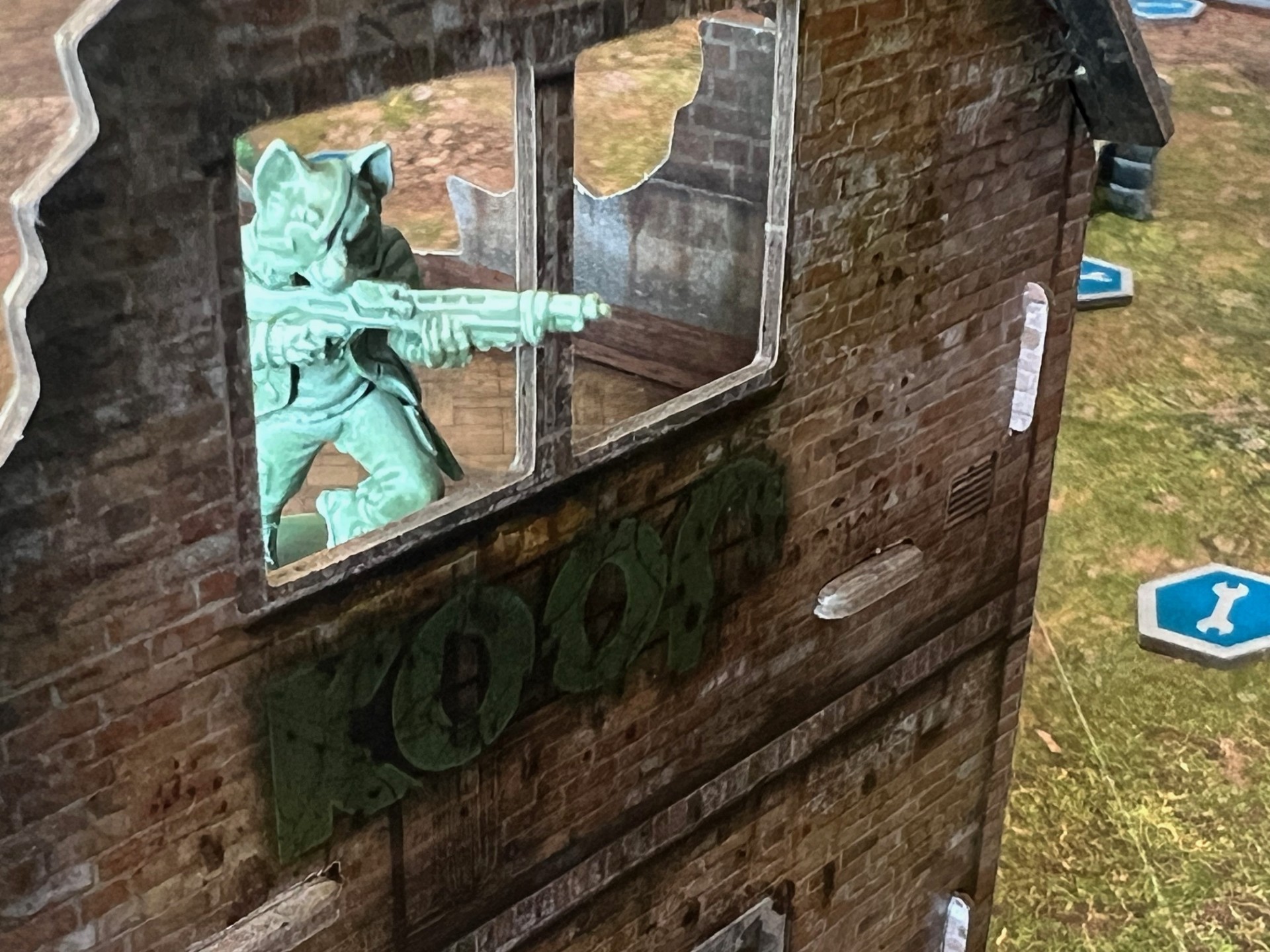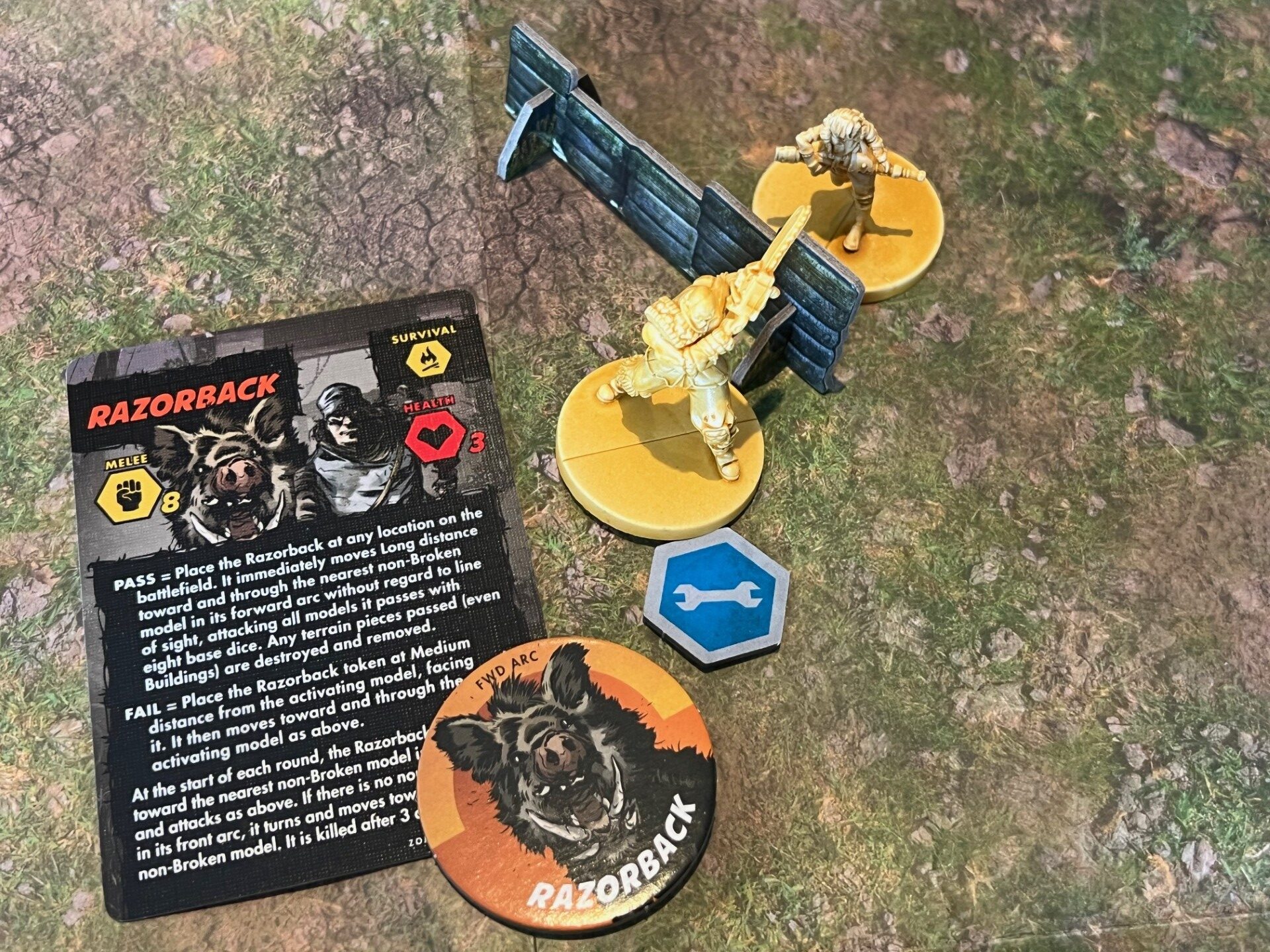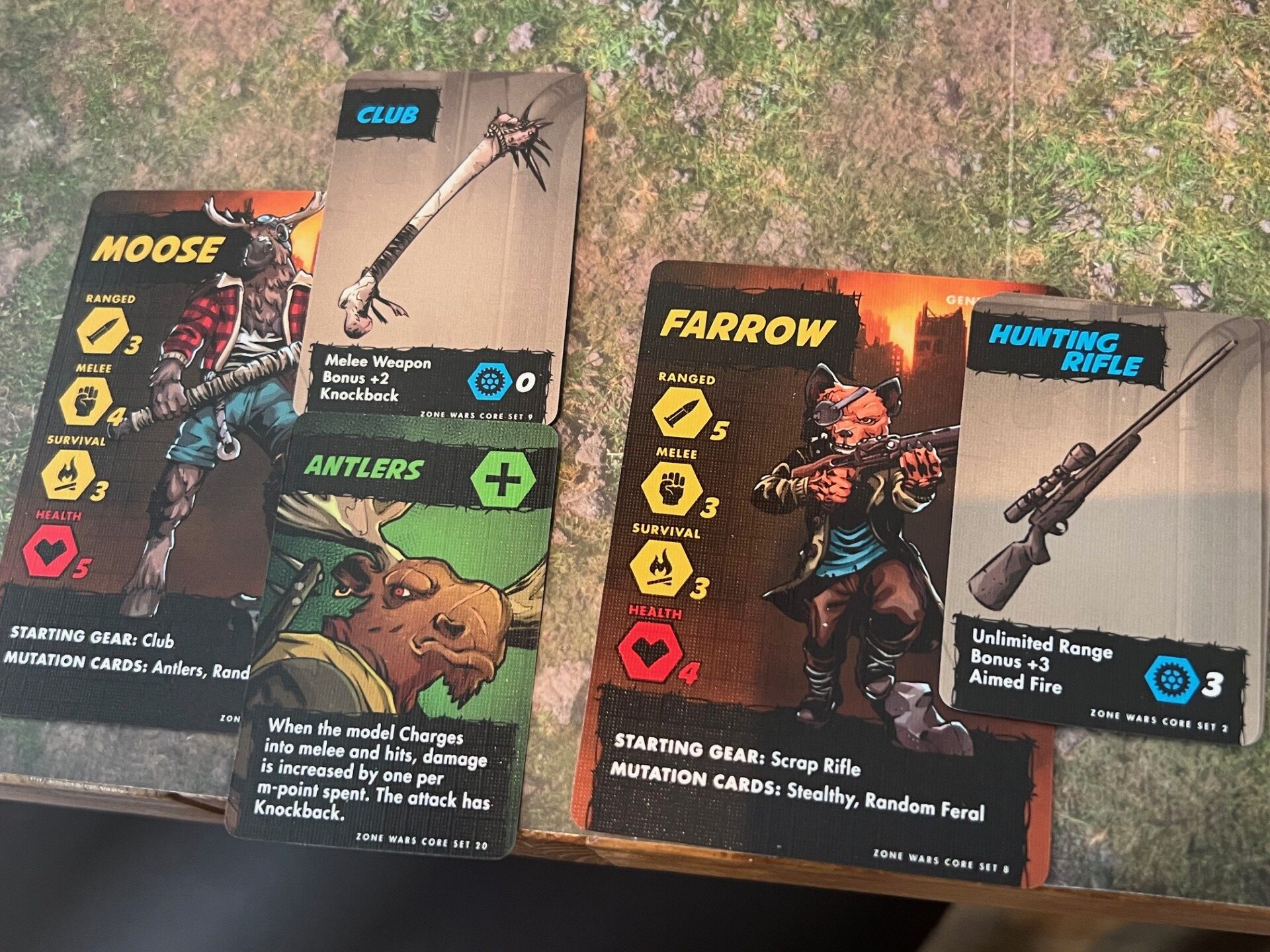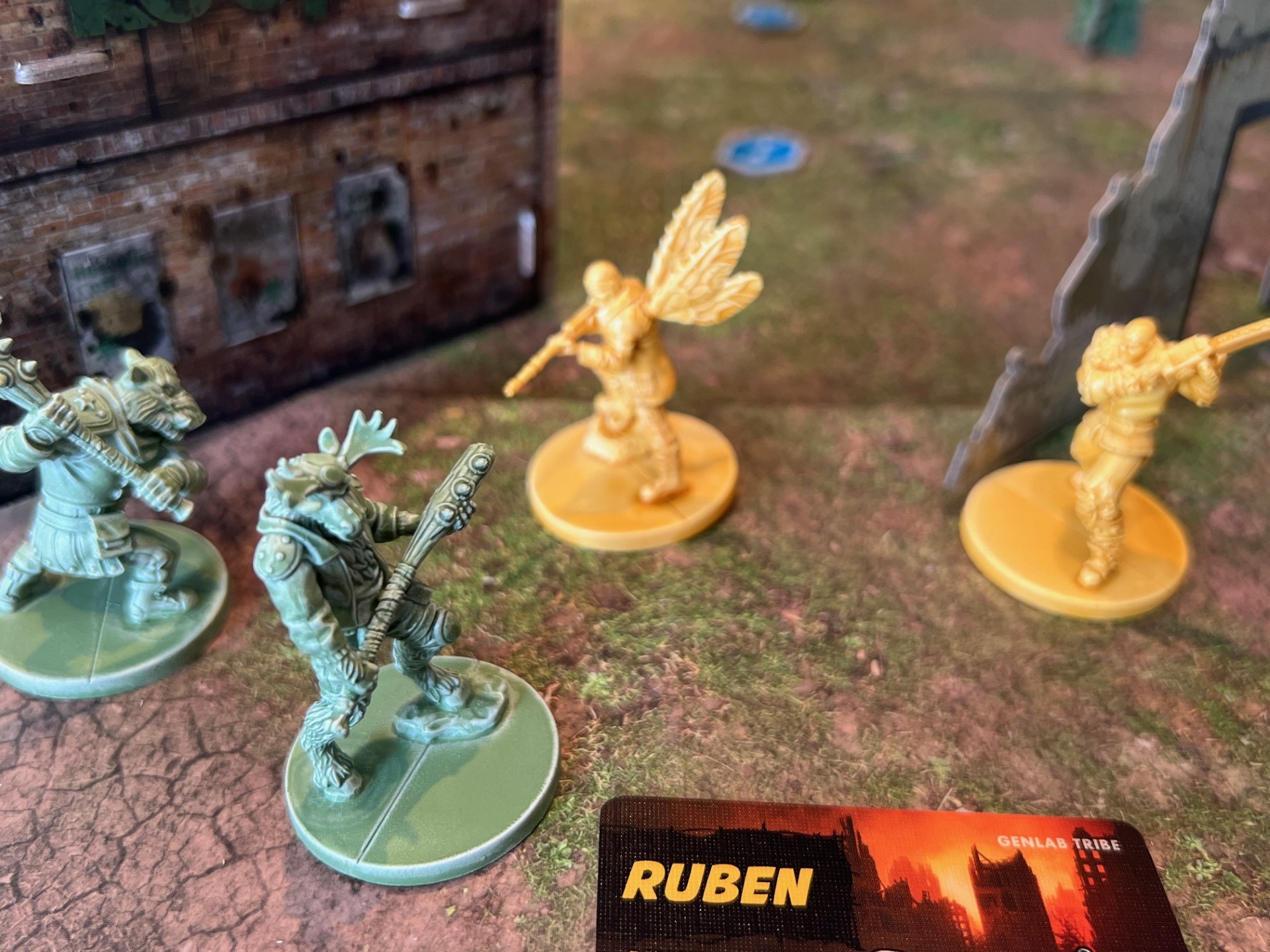Mutant Year Zero: Zone Wars is a fast-paced skirmish game that is great for casual combatants
Here at BigBossBattle, we are big fans of Free League Publishing, with reviews of both Tales From the Loop: The Board Game and Forbidden Lands under our belts. You can imagine my excitement then, when I heard about Mutant Year Zero: Zone Wars, which is basically a skirmish game set in the same universe (and featuring the same characters) as those seen in the popular but overlooked cult video game in turn based off their ttRPG system.
Mutant Year Zero: Zone Wars is presented in two separate boxes — which I initially thought were separate core sets featuring two opposing factions in each box. As a matter of fact, one of these boxes (the orange one) is the core set, with the blue box gaining the additional moniker of “Robots and Psionics.” Neither box really makes it clear which is or isn’t a core set or an expansion, but now that you’ve read this it shouldn’t really matter, because you should actually go and buy both anyway.

Ignoring the absence of an instruction manual and a few ancillary elements, the contents of both packs are broadly similar. Each one contains two factions of five characters — presented as large, detailed miniatures in a faction-specific colour and washed in a nice sundrop shade — and all of the cards you need to use them. There are tokens and dice as needed, and perhaps my favourite thing about this game: Quite a lot of robust, cleverly designed cardboard scenery.
The core set features a double-sided paper map which is a welcome addition, and generally — as someone who doesn’t invest in skirmish games — I really welcome the cardboard scenery, the maps and the pre-shaded miniatures. Everything about the presentation of Mutant Year Zero: Zone Wars says to me that the designers wanted to attract casual fans to skirmish games and to give them a complete experience.

This continues into the rules and the system itself. The rulebook isn’t perfect and it lacks clear examples and occasional clarifications, but what it lacks in the kind of polished detail you might expect from a large publisher like Atomic Mass Games, it makes up for in brevity and getting the players to the table quickly. Everything is there – from movement using the range ruler (again, included only in the core set) to how combat, line of sight and other key aspects are resolved — it’s just that when edge cases and ambiguities occur, you may need to solve them yourself.
Most aspects of playing Mutant Year Zero: Zone Wars occur as you might expect. Movement is simple, cover works in a logical way and combat (or other tests which I’ll explain in a moment) are resolved by simply rolling sixes to denote success. In most cases, a character being more proficient at something will result in more dice to roll, rather than a modification to the outcome on the dice being needed.

To make a simple example of combat, if a character has a ranged skill of four, they will roll four (yellow) dice when using a ranged weapon, and then any additional black dice that the weapon itself adds. Rolling sixes on these dice will result in hits on the opponent, which may then be modified by things like armour or mutations held by the targeted mini – although these are relatively uncommon.
The really interesting bit about this dice resolution is that the player can choose to “push” their roll — by removing all dice that showed one, and rerolling the rest. The downside here is that pushing weapons can cause damage to them, and in any case, ones rolled on yellow dice will generate mutation (or M) points that can be used to power mutations. I really like the risk and reward aspect of pushing dice rolls, and I also like how M points are returned when a dice is rolled as a one and ruled out of a further re-roll. Some attacks fail entirely but generate M points for later turns — and this is a nice feature.

Other tests work the same way — often measured against the “survival” stat of a character being tested. There are many occasions where tests might occur, but one of the most interesting (which is unique to Mutant Year Zero: Zone Wars) is that of “Zone Effects” which are basically random or occasionally scripted events drawn from a deck or the current scenario. Failing a survival test when a Zone Effect is resolved can have variable (and often negative) consequences, but it adds to the theme and the fun of the overall experience.
Other things that make Mutant Year Zero: Zone Wars feel quite unique and fun are the mutations, or modifications that I’ve just referred to. Each faction has its own “kind” of adaptation, with the core set factions having either feral or physical mutations, the robots having modifications and so on — I say that because I imagine there’ll be future sets and as long as a word beginning with “M” can be found to suit that faction, that’s what the deck of adaptations will be called.

Most characters have one fixed adaption as shown on their character card and one random one, leading to some interesting combinations. The fixed adaptations are almost always thematic, gifting the character in question an ability that will be familiar to players of the video game — whether that be large horns, a duck’s bill or the ability to release spores that spread outwards to a certain distance.
I mentioned already how much I like the included scenery, and there’s no doubt that it makes for a standout feature of Mutant Year Zero: Zone Wars. With the mat set out and the crumbling buildings set out, Mutant Year Zero: Zone Wars looks superb. This fantastic look, along with the small number of units on each side (sometimes as low as two or three if you are just learning) makes the game very appealing to newcomers, and a single game can be over in half an hour. This allows basic principles to be learned quickly, and for the next, often more complex, scenario to be set up.

Other things I liked about Mutant Year Zero: Zone Wars were how a unit that reaches it damage limit would have its character card flipped to the “bloodied” side, which also forces them to rally — but with the option to continue the fight if they do so. Items are fun as well, with starting items being quite basic, but others up for grabs at various objective tokens throughout each scenario. This gives the sense that characters get progressively more powerful as the game goes on, and alongside the M point growth, helps to maintain that rapid play time.
In summary, I don’t really play skirmish games very often, mainly because of the investment in building miniatures, painting them, a lack of scenery and space etc — but Mutant Year Zero: Zone Wars solves almost all of these problems. In just two small boxes, I now have everything I need to get friends involved in a casual skirmish game that has almost all of the rules of any “more advanced” game, as well as a load of unique and thematic elements of its own. With that said, I have to say that I recommend Mutant Year Zero: Zone Wars if that sounds like a brief that you’re also looking to meet.
You can find the Mutant Year Zero: Zone Wars core set and expansion on Amazon.
Comments are closed.